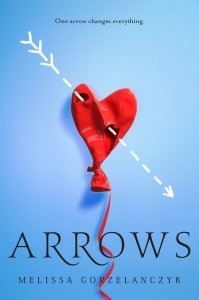 The
The  launch of Green Bay author Melissa Gorzelanczyk’s debut Young Adult novel ARROWS (Delacorte Press, 2016) is one example of how social media can play an important role in author success.
launch of Green Bay author Melissa Gorzelanczyk’s debut Young Adult novel ARROWS (Delacorte Press, 2016) is one example of how social media can play an important role in author success.
Melissa’s novel ARROWS is a modern cupid story set in present-day Wisconsin combining the fantastical elements of Greek mythology with the contemporary drama of MTV’s Teen Mom,” according to Melissa’s website. Her novel also has an element of social justice – a young woman learning how to leave a bad relationship.
I asked Melissa that favorite question of up-and-coming authors: How did she find her literary agent?
During a Twitter pitch party.
That’s right. What’s a Twitter pitch party, you ask? Here’s how it works. Periodically on Twitter, moderators will host an event during which writers have the chance to pitch their manuscripts to agents. What’s tricky is Twitter’s 140-character limit. You must summarize your novel in a very compact and effective sentence.
That’s a challenge for any writer who has faced the agony of writing a query letter, during which an author must summarize his or her novel in an accurate and enticing premise within a few short sentences. Now tighten that.
“I actually recommend creating a Twitter pitch for every story that you start, even if you’re never going to pitch it that way,” Melissa says. “It makes you look at the true bones of your story.”
This is an unusual way to obtain an agent. Twitter pitches aren’t a substitute for a query letter or a good book proposal. Some agents won’t consider pitches on Twitter or other social media venues, and most have very specific rules regarding submissions. And, as always, anyone who considers pitching a novel (no matter how you end up doing it) must have a completed, solid manuscript and proposal in hand. But Twitter is one new way some agents engage with up-and-coming fiction writers.
“I was really drawn to the idea of this contest,” Melissa says. “One, it was something I had never tried to do, and two, I could learn something from it. It’s so important to be able to pitch a story in general. And this was a newer, more spare way to do that.”
During these pitch contests, agents will “like” your pitch if they’re interested in seeing more. Melissa’s pitch – which simply listed a link to an excerpt of her manuscript – caught the attention of Donadio & Olson agent Carrie Howland. You can read the whole store about Melissa’s #PitMad experience here.

“She basically said, I’d love to represent this book and your career,” Melissa said. “It was that moment I had been waiting for.” Melissa said it came with a bit of disbelief but also satisfaction.
“You’ve worked so hard to get to that point, as any author knows,” she said. “You’re working through revisions, you’re getting critiques, you’re going to conferences, you’re learning, you’re following people on Twitter. So when it happens it does feel like, yeah, this feels right.”
Carrie worked with Melissa through two revisions, including one that was fairly heavy and eliminated a character, and then a line edit that tightened the manuscript, before helping the novel find a home with Delacorte Press.
 How do you find these Twitter pitch events? You can use a search engine to find the latest dates for “Twitter pitch parties.” One of the most popular—where Melissa found her agent—is #PitMad, or Pitch Madness, hosted by author Brenda Drake. Drake’s pitch event allows you to work with pitch mentors to help you write (or, as in Melissa’s case, even write for you) the best, most eye-catching tweets. Another event, #PitchMas, occurs during the winter holidays.
How do you find these Twitter pitch events? You can use a search engine to find the latest dates for “Twitter pitch parties.” One of the most popular—where Melissa found her agent—is #PitMad, or Pitch Madness, hosted by author Brenda Drake. Drake’s pitch event allows you to work with pitch mentors to help you write (or, as in Melissa’s case, even write for you) the best, most eye-catching tweets. Another event, #PitchMas, occurs during the winter holidays.
If you’re planning to participate, you should research the rules of each pitch contest carefully. Most will limit the number of pitches you can make. It’s also very important not to “like” (clicking the heart in the body of the tweet) other writers’ pitches during these contests to avoid confusion (and disappointment). The etiquette is to “retweet” pitches you like instead.
 Additionally, your pitch must be short enough to leave room for hashtags. What are hashtags? Anytime you use the “#” mark in front of a word or phrase, anyone searching that word or phrase will see those tweets. Each contest has its own hashtag, and you should denote your manuscript’s genre as well (i.e. #YA for Young Adult, #MG for Middle Grade, and #SFF for Sci-Fi/Fantasy.)
Additionally, your pitch must be short enough to leave room for hashtags. What are hashtags? Anytime you use the “#” mark in front of a word or phrase, anyone searching that word or phrase will see those tweets. Each contest has its own hashtag, and you should denote your manuscript’s genre as well (i.e. #YA for Young Adult, #MG for Middle Grade, and #SFF for Sci-Fi/Fantasy.)
Melissa says even if you’re not planning to participate in a pitch event, Twitter is a good way to follow agents and see what kinds of manuscripts they like. Hint: Check the hashtag “#mswl” which stands for “manuscript wish list” – you’ll see what kinds of stories agents want to read.
To attend Melissa’s launch party and get your own copy of ARROWS, visit Barnes & Noble at 2498 S. Oneida St. Green Bay, WI 54313 between 2 and 4 p.m. Saturday, January 30.

That’s fascinating. And thanks for the #mswl thing. I love Twitter.
Thanks for the information. More tools in my tool-belt.